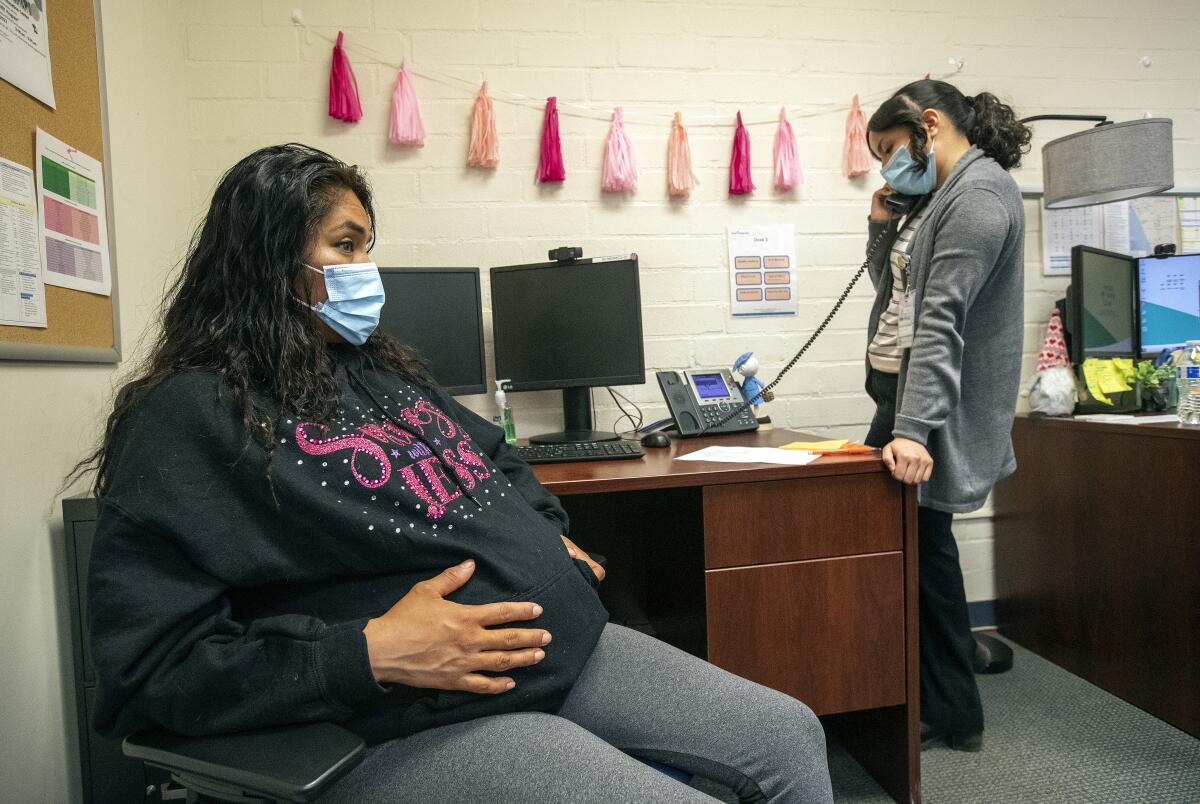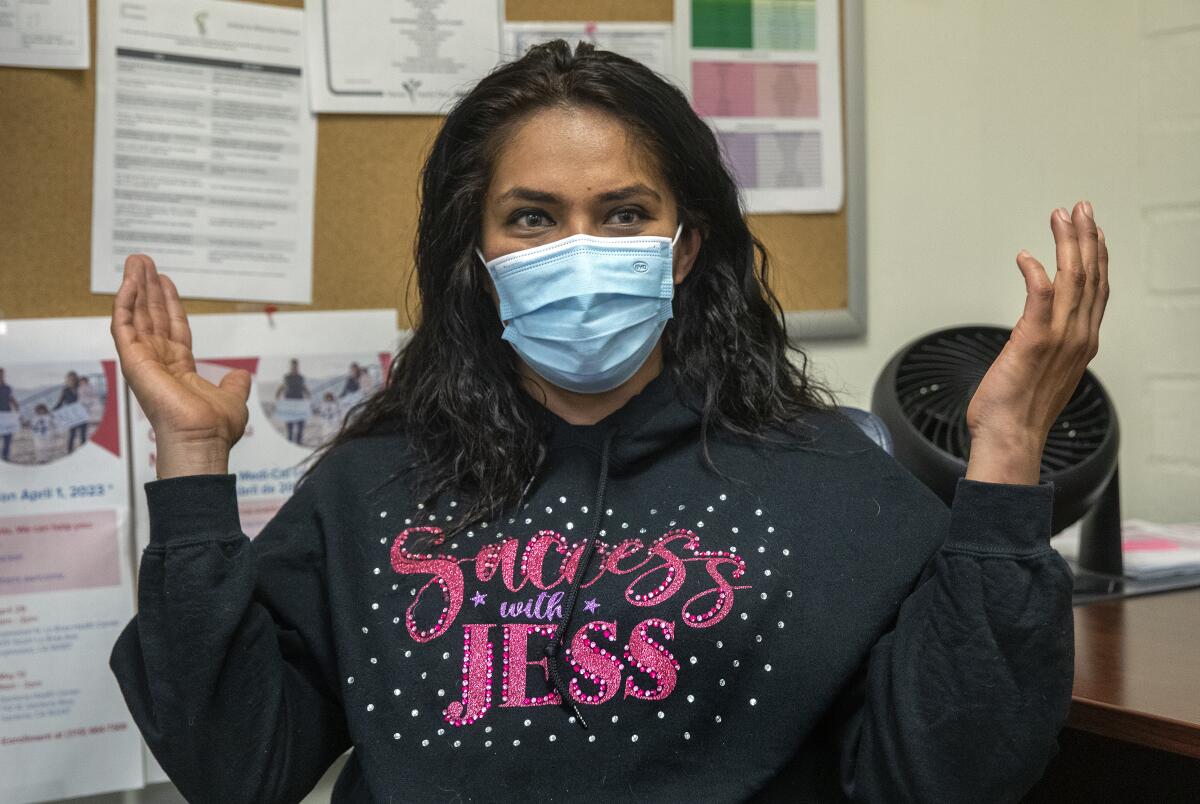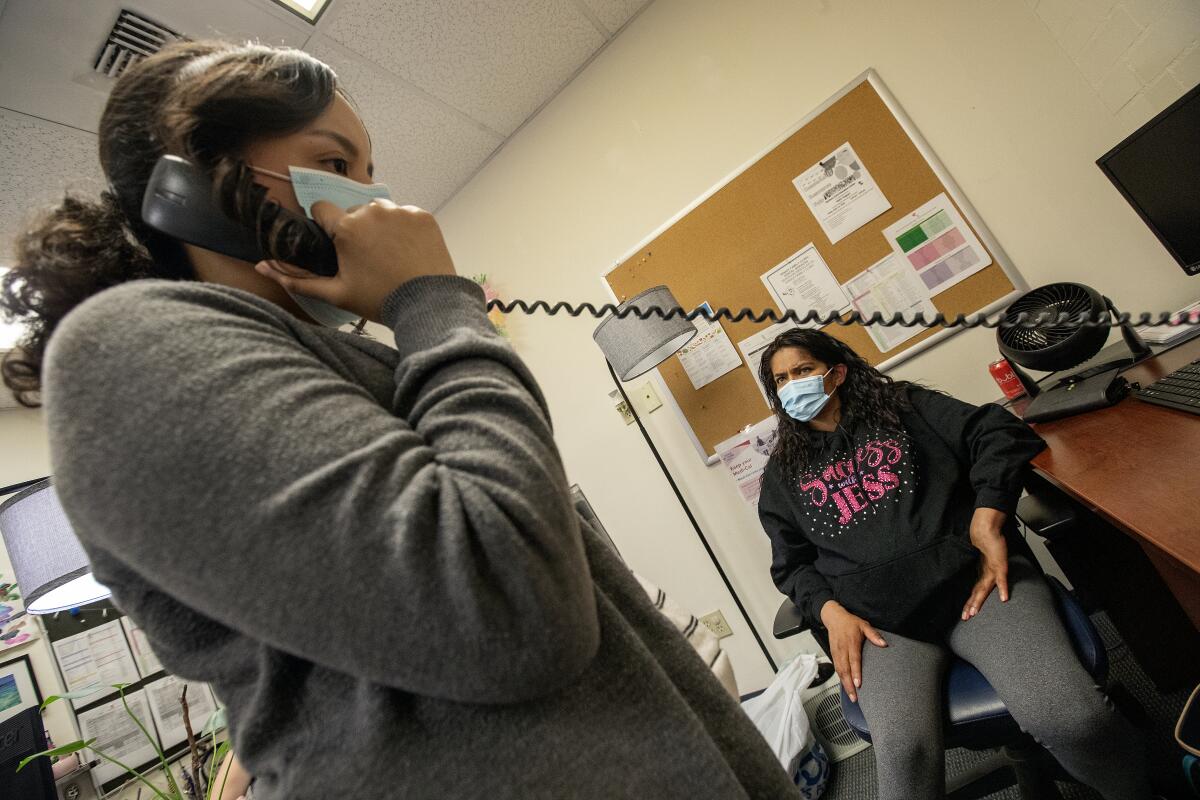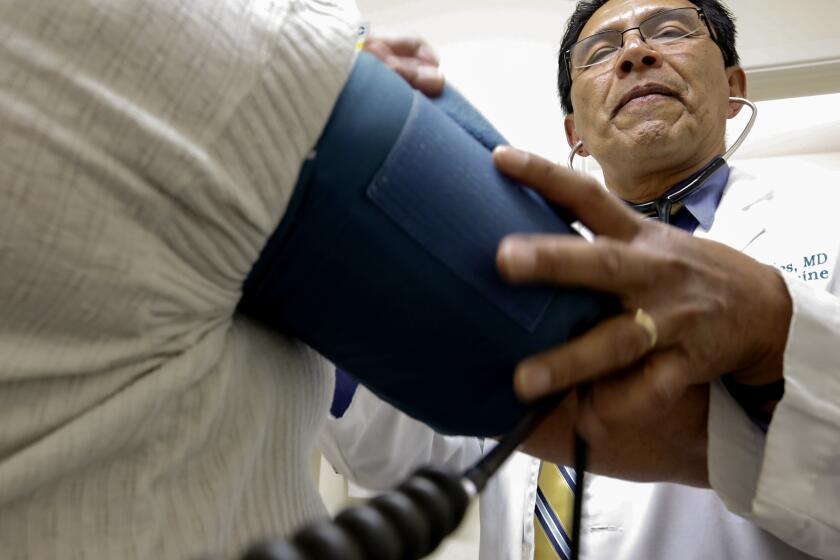‘A perfect storm’: Patients trying to hang on to Medi-Cal face long waits for help

Canned music droned from the telephone as Jessica Sanchez waited, fidgeting and shifting her pregnant belly in her chair at the Santa Monica community health center.
It had been an hour since Sanchez and a Venice Family Clinic worker had dialed up a Los Angeles County agency for help. At a prenatal appointment, Sanchez, 33, had abruptly discovered that her health coverage had been cut off months earlier. The news rattled Sanchez, who was already in her third trimester.
A looping recorded voice repeatedly told her, “Your call is important to us. Please remain on the line.” Sanchez checked her phone, then pulled out a bundle of pastel yarn and resumed crocheting for the baby boy she is expecting.
“By the time they pick up,” Sanchez, 33, said, “I’m going to be done with this blanket.”

As the federal government has rolled back rules that helped people hang on to Medicaid during the COVID-19 pandemic, health providers fear the fallout could be disastrous for patients. The federal rules had prevented states from booting people from the program, even if changes such as a bump in income would otherwise make them ineligible.
Now millions of people are expected to lose their Medicaid coverage — including many who still qualify — as California and other states go back to checking that people meet the requirements. Federal officials estimate that nearly three-fourths of children and teens who lose coverage will do so even though they remain eligible for the program.
California will soon require Medi-Cal recipients to prove their eligibility again. But it has a safety net for people who lose their coverage.
Keeping eligible patients on Medicaid has long been a “bureaucratic nightmare,” said Jim Mangia, president and CEO of St. John’s Community Health, a network of community clinics in the Los Angeles area. Before the pandemic began, he said, hundreds of their patients would accidentally lose their coverage every month. “Now it’s going to become an outright disaster.”
Many people have moved or been displaced during the pandemic and could miss out on important notifications that their coverage is in jeopardy, Mangia said. If they fail to return the needed paperwork on time, they could lose their coverage under Medi-Cal, the California Medicaid program. He estimated that between 10% and 15% of St. John’s patients could lose out.
Community clinics say that many patients are also dealing with long waits for help from L.A. County, which they expect will only worsen with millions of people countywide up for renewal throughout the coming year. The Medi-Cal cases are coming up on a rolling basis, with another round of patients up for renewal each month.
David Kane, an attorney at the Western Center on Law and Poverty, called it “a perfect storm.” Record enrollment in Medi-Cal amid the pandemic means that huge numbers of Californians will need to go through the renewal process, potentially overwhelming county agencies tasked with handling the renewal process, many of them short on staff. Before the renewal process began, L.A. County officials told the state that they expected to need more staff and cautioned that new hires might be slower at handling cases.
“We’ve gotten no reassurances that they are completely ready for this,” Kane said. Legal advocates have sued the county in the past for wrongfully halting Medi-Cal coverage for thousands of people, and a judge ruled five years ago that the county had violated the law by terminating coverage even though people had turned in their paperwork on time.
Nick Ippolito, an assistant director in the L.A. County Department of Public Social Services, said that “we are doing everything we can to help our customers preserve their Medi-Cal coverage with no or minimum interruption.”
He said the department had made a strategic decision to keep sending out the usual paperwork during the COVID-19 emergency — without cutting them off if people didn’t send it back — so that Medi-Cal enrollees might get into the habit of seeing and returning the packets and reporting back with any new information.
Many Angelenos could have their Medi-Cal automatically renewed as the county checks information against a federal database for other government programs. At a recent meeting of the county Board of Supervisors, department director Jackie Contreras said that tens of thousands of cases a month are expected to be successfully handled through automatic renewal, which means the person would simply get a notice that their Medi-Cal coverage is continuing.
But many more — upward of 120,000 in June alone, including some people who are undocumented or others whose cases cannot be verified by the federal database — will probably need to be manually processed, requiring people to submit their information by mail, phone, online or at a county office to keep their health coverage, according to county figures.
At the county meeting, community clinics and other advocates raised concerns about how that might play out. For instance, there is a state website where people can fill out their renewal information, called BenefitsCal, but a Venice Family Clinic staffer told the county board that it was failing to recognize uploaded paperwork or even simple changes of address.
As of earlier this year, BenefitsCal was being used for only a fraction of Medi-Cal applications or renewals, according to statewide data. Lena Silver, associate director of litigation and policy advocacy at Neighborhood Legal Services of Los Angeles County, said that even creating an account can be difficult for some Medi-Cal recipients who do not have email accounts or internet access. When someone creates an online account, the system also has to link that new account to state information about their benefits, but that doesn’t always work, Silver said.
“Because of all these struggles with the online system, people eventually end up calling, which also crowds the lines,” said Dina Dimirjian, staff attorney with the Health Consumer Center at Neighborhood Legal Services of Los Angeles County.
Contreras told county leaders that wait times had averaged more than 40 minutes in January and less in February, but would probably be higher in March, possibly as long as an hour and a half depending on the time of day. Ippolito, in an interview, said Medi-Cal is its most complex program and “you have to spend some time with people on the phone to answer their questions.”
Valerie Ibarra-Figueroa, a health insurance specialist at Venice Family Clinic who was helping Sanchez, said she is used to having to wait upward of an hour on the phone with the county when patients face problems with Medi-Cal. She has to carefully juggle any other work while on hold, since she has to be ready immediately when someone picks up or risk a hangup, she said.
Sanchez had been waiting with Ibarra-Figueroa for more than an hour for someone to pick up her call when a DPSS worker finally answered the line. Ibarra-Figueroa quickly handed the phone to Sanchez, who explained that she was 31 weeks pregnant and had just found out that her coverage was discontinued.
“So can you guys get it to be active now?” she asked.

After some back-and-forth, Sanchez put Ibarra-Figueroa back on the line to make sense of what she was being told. “I understand the process regarding that,” Ibarra-Figueroa said on the phone. “But due to the pandemic protections, she shouldn’t have been cut off anyways.”
Ibarra-Figueroa said she couldn’t get a clear explanation for why Sanchez had lost her health coverage in February, before the federal rule had been rolled back. DPSS officials have said that as renewal paperwork starts getting mailed out this month, no one would get their Medi-Cal cut off for failing to return it before the end of June.
To fix the problem, Sanchez, who had been working as a housekeeper before her pregnancy made it difficult to continue, was ultimately asked to write out an affidavit explaining her financial situation, which Ibarra-Figueroa quickly scanned and uploaded for the county to review.
After the call, Sanchez fretted aloud about what could happen before her Medi-Cal coverage was restored.
“What if I give birth before then?” Sanchez asked.
Kane pointed out that last year, an average of more than 178,000 calls to DPSS were abandoned every month — more than a quarter of the calls coming into the customer service center, according to county data — and tens of thousands more were met with a “high call volume” message telling them to call back later.
Even when clinic workers and patients get through on the phone, “sometimes we don’t get the support that they need,” said Karem Martinez, a lead enroller at East Valley Community Health Center who is based in Pomona. “We either get rerouted back to the queue and have to wait again — or they just hang up on us.”
During the pandemic, L.A. County saw its number of Medi-Cal cases surge from under 1.7 million to nearly 2.2 million, as people were able to keep their coverage, according to county data. DPSS staffing has not kept pace with its growing caseload across programs, Ippolito said. The L.A. County department has been hiring, but it has been grappling with attrition: Contreras told county officials that her department had 167 vacancies for workers handling Medi-Cal, which she projected would be filled by May, but would have more positions to fill again in June.
If “we don’t get ahead of our attrition, having more positions isn’t going to help,” Contreras told the board.
The L.A. County workers handling calls make between $43,000 and $62,000, according to Ippolito.L.A. County Supervisor Holly Mitchell said that as the county agency faces the upcoming wave of renewals, “they’re in as good a position as they possibly could be.” But “when Starbucks has sandwich boards out in front of their stores saying, ‘We will pay for child care’ ... everybody is hustling to try to get top talent,” she said.
Contreras told county supervisors that the state is poised to allocate $34 million to help the department handle the renewals, which could help bolster hiring. But the funding is a one-time allocation, and “obviously we want to be able to hire someone and keep them on,” Ippolito said.
Meanwhile, Sanchez got a call from the county a few days after her visit to the Santa Monica clinic and shortly before she was due for her next ultrasound.
Her Medi-Cal had been reinstated, she was told, to her great relief.
More to Read
Sign up for Essential California
The most important California stories and recommendations in your inbox every morning.
You may occasionally receive promotional content from the Los Angeles Times.










